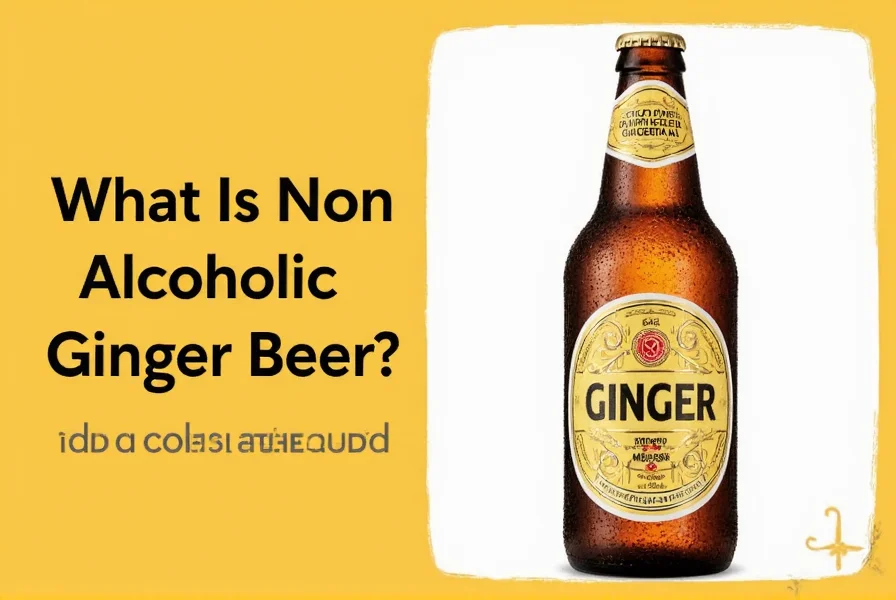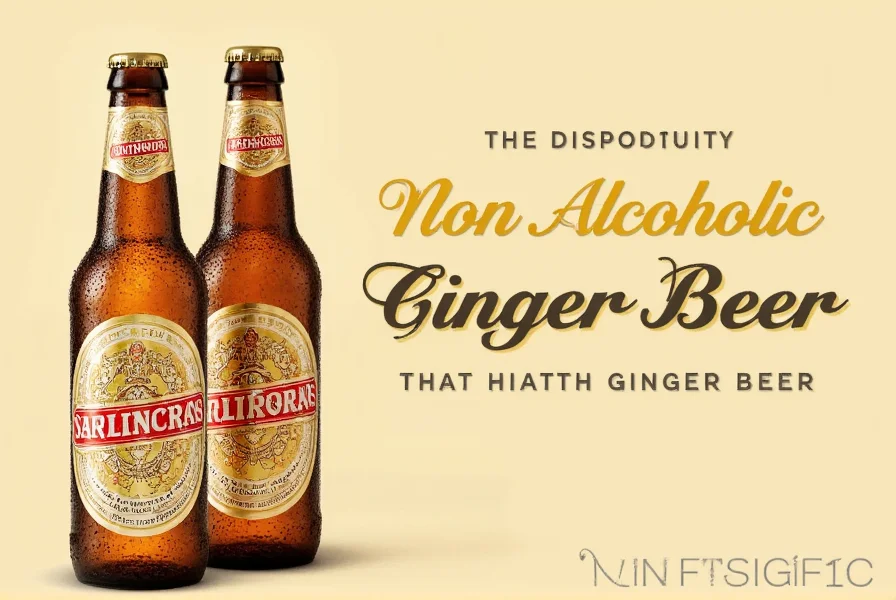For centuries, ginger beer has evolved from a fermented beverage to the widely available non-alcoholic version enjoyed globally today. Understanding the distinction between traditional and contemporary preparations helps consumers make informed choices about this refreshing drink.
The Evolution of Ginger Beer
Ginger beer originated in 18th century England as a fermented beverage made with ginger, sugar, water, and a symbiotic culture of bacteria and yeast called the "ginger beer plant." This traditional preparation naturally produced 3-11% alcohol through fermentation. Modern commercial production shifted to non-alcoholic versions in the 20th century, replacing natural fermentation with carbonation while preserving the distinctive ginger flavor.
How Non Alcoholic Ginger Beer Is Made
Contemporary production methods for non alcoholic ginger beer follow a precise process that maintains flavor integrity without significant alcohol content:
| Production Stage | Traditional Method | Modern Non-Alcoholic Method |
|---|---|---|
| Base Ingredients | Ginger, sugar, water, ginger beer plant | Ginger extract, sugar, water, citric acid |
| Fermentation | Natural fermentation (3-14 days) | No fermentation or minimal fermentation stopped early |
| Carbonation | Naturally occurring from fermentation | Forced carbonation under pressure |
| Alcohol Content | 3-11% ABV | Less than 0.5% ABV |
| Shelf Life | Short (requires refrigeration) | Extended (6-12 months unopened) |
The manufacturing process begins with creating a ginger syrup by boiling fresh or dried ginger with water and sugar. After straining, manufacturers add natural flavorings like lemon juice or additional spices. Instead of allowing natural fermentation to occur, producers immediately carbonate the liquid under pressure. This method preserves the spicy ginger flavor while eliminating significant alcohol production.

Key Ingredients and Their Roles
The distinctive character of non alcoholic ginger beer comes from carefully balanced ingredients:
- Fresh ginger root - Provides the signature spicy heat and aromatic compounds; higher quality brands use real ginger extract rather than artificial flavors
- Sugar or sweeteners - Balances ginger's natural heat; traditional recipes use cane sugar while modern versions may incorporate alternative sweeteners
- Citric acid - Enhances flavor brightness and acts as a preservative
- Natural flavorings - Lemon, lime, or additional spices like cinnamon may be added for complexity
- Carbonated water - Creates the effervescent texture that defines ginger beer
When evaluating different brands of non alcoholic ginger ale versus ginger beer, consumers should note that ginger beer typically contains more ginger root extract, resulting in a spicier, more robust flavor profile compared to the milder ginger ale.
Popular Uses and Serving Suggestions
Non alcoholic ginger beer serves multiple purposes beyond being a standalone beverage:
- Mocktails - Forms the base for alcohol-free versions of classic drinks like the Moscow Mule (using ginger beer, lime, and sparkling water instead of vodka)
- Culinary applications - Adds depth to marinades, glazes, and sauces for meats and vegetables
- Mixing with other beverages - Combines well with fruit juices, lemonade, or tea for refreshing spritzers
- Digestive aid - Many people consume small amounts to soothe upset stomachs, though this shouldn't be considered medical advice
Comparing Non Alcoholic Ginger Beer to Similar Beverages
Understanding the differences between related beverages helps consumers select the right product for their needs:
- Ginger beer vs. ginger ale - Ginger beer contains more ginger root extract, resulting in a spicier, more robust flavor with less sweetness than ginger ale's milder profile
- Non alcoholic vs. traditional ginger beer - The non-alcoholic version uses forced carbonation rather than fermentation, containing less than 0.5% alcohol versus 3-11% in traditional versions
- Commercial vs. homemade non alcoholic ginger beer - Store-bought versions offer consistency and longer shelf life, while homemade allows for customization of spice level and sweetness
Storage and Shelf Life Guidelines
Proper storage maintains the quality of non alcoholic ginger beer:
- Unopened bottles maintain peak quality for 6-12 months when stored in a cool, dark place
- Refrigerate after opening and consume within 5-7 days for best flavor
- Avoid temperature fluctuations which can affect carbonation levels
- Check for signs of spoilage including off odors, unusual cloudiness, or loss of carbonation
Simple Homemade Non Alcoholic Ginger Beer Recipe
Creating your own non alcoholic ginger beer allows customization of spice level and sweetness:
- Peel and finely grate 1 cup of fresh ginger root
- Combine ginger with 4 cups of water and 1 cup of sugar in a saucepan
- Bring to a simmer, then reduce heat and steep for 20 minutes
- Strain the liquid through a fine mesh sieve
- Cool completely, then add juice of 1 lemon
- Pour into plastic bottles, leaving 2 inches of headspace
- Refrigerate and carbonate by shaking gently before serving
This preparation method creates a naturally carbonated beverage without significant alcohol production. For completely alcohol-free results, refrigerate immediately after cooling rather than allowing any fermentation time.
Frequently Asked Questions
Is non alcoholic ginger beer completely alcohol-free?
Non alcoholic ginger beer typically contains less than 0.5% alcohol by volume, which qualifies as non-alcoholic according to most regulatory standards. While not 100% alcohol-free, this amount is comparable to what occurs naturally in fruit juices and kombucha. Completely alcohol-free versions are available from some specialty producers who avoid even minimal fermentation.
How does non alcoholic ginger beer differ from ginger ale?
Non alcoholic ginger beer contains a higher concentration of ginger root extract, resulting in a spicier, more robust flavor profile with less sweetness. Ginger ale is typically milder, sweeter, and has a lighter ginger flavor. The carbonation level in ginger beer is usually more intense than in ginger ale, creating a more pronounced effervescence.
Can children safely drink non alcoholic ginger beer?
Yes, non alcoholic ginger beer is generally considered safe for children as it contains minimal to no alcohol. However, parents should check sugar content as some commercial varieties contain significant amounts of added sugar. For children with sensitive stomachs, the spicy nature of ginger might cause mild discomfort in some cases.
Does non alcoholic ginger beer offer the same health benefits as fresh ginger?
Non alcoholic ginger beer contains some beneficial compounds from ginger, though typically in lower concentrations than fresh ginger due to processing and dilution. The pasteurization process used in commercial production may reduce some active compounds. While it may provide mild digestive benefits for some people, it shouldn't be considered a significant source of ginger's potential health properties.
Why does non alcoholic ginger beer sometimes taste different between brands?
Variations in taste come from differences in ginger source and concentration, sweetener types, additional flavorings, and carbonation levels. Premium brands typically use higher quality ginger extracts and natural ingredients, while budget options may rely more on artificial flavors and higher sugar content. The specific ginger variety used (like Nigerian, Chinese, or Australian ginger) also affects the final flavor profile.











 浙公网安备
33010002000092号
浙公网安备
33010002000092号 浙B2-20120091-4
浙B2-20120091-4